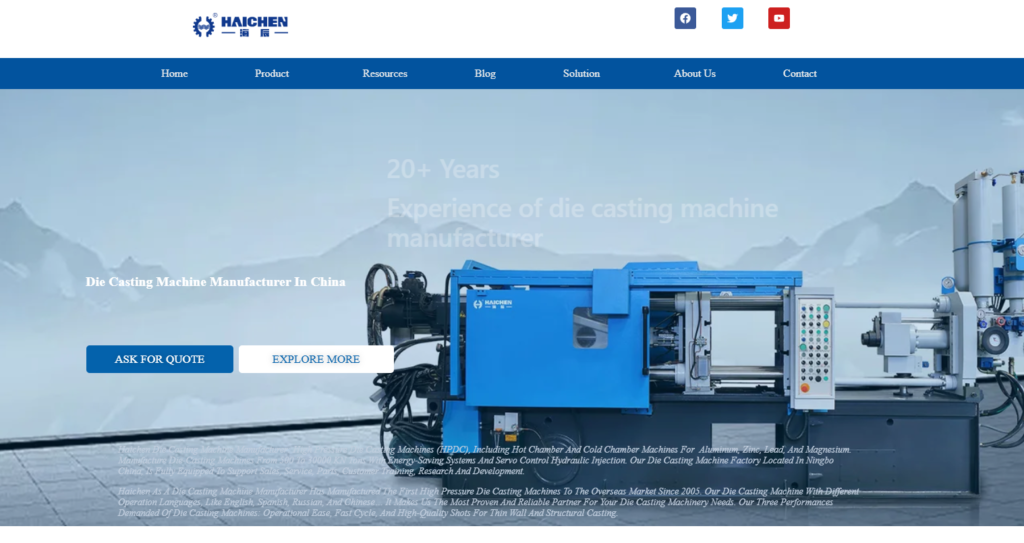Pressure casting is quickly cooled and formed by injecting molten metal into a precision metal mold cavity at high pressure (5-150MPa) and high speed (5-100m/s).
Pressure Casting is mainly divided into High Pressure Die Casting (HPDC) and Low Pressure Die Casting (LPDC).
In the design of low-pressure die-casting molds, the use of sand cores requires the comprehensive application of structural optimization, material selection, process coordination and manufacturing technology to achieve high-quality and high-efficiency production of castings.
Pressure casting
Definition: Molten metal (e.g., aluminum, zinc, magnesium) is injected into a steel mold (Die) under high pressure (typically 10-200 MPa) and quickly cooled to form.
Features: High precision (tolerance class IT13-IT15) and surface finish (Ra 0.8-3.2μm).
Suitable for mass production, the cold chamber die casting machine can reach 50-90 times per hour.
And the hot chamber die casting machine can reach 400-900 times.
Complex geometries and thin-walled parts can be manufactured (minimum wall thickness of 0.5 mm for aluminum and 0.3 mm for zinc).

Sand Casting
Sand casting is a traditional casting method that uses molding sand (a mixture of silica sand, clay and water) to compact into a casting mold.
Which is poured by gravity to cast molten metal and cooled to form a casting.
It is characterized by low material cost and wide adaptability, suitable for steel, iron.
And most non-ferrous alloys, especially suitable for the production of single pieces, small batches and large castings.

Forging
Precision casting is a general term for a class of high-precision casting processes.
Including investment casting, ceramic mold casting, metal mold casting, etc.
At its core, the metal solidification process is controlled by precision molds.
Such as wax molds or ceramic shells, resulting in dimensionally accurate, surface finishes for castings, often without the need for post-processing.
Investment casting (lost-wax method) is a typical example of this, suitable for complex thin-walled parts and high-performance demand areas.

Weld
Welding is the technique of creating a permanent connection between two or more workpieces at the atomic level by heating or pressurizing (or a combination of both).
Fusion welding
The workpiece is heated until it melts to form a molten pool, and then it is connected after cooling (such as arc welding, laser welding).
Pressure welding
Pressurization at a temperature below the melting point to make the workpieces penetrate and bond with each other (e.g. resistance welding, friction welding).
Brazing
Utilizing a low melting point filler material, such as solder, to join the workpiece by capillary action, and the base metal does not melt.
Welding consumables
Metal type: carbon steel, stainless steel, aluminum alloy, titanium alloy, nickel-based alloy (e.g. Inconel).
Filler material: welding rod (such as 7018, 6013), welding wire (such as ER70S-6), brazing metal.
Such as silver base, copper base
Special requirements: the chemical composition of the base metal needs to be matched.
And some materials need shielding gas (e.g. argon for TIG welding).
Stamping
Stamping is a processing method that uses presses and dies to apply external force to metal materials.
Such as plates, strips, tubes to plastically deform or separate.
So as to obtain the desired shape and size of the workpiece.
The three elements of stamping: molds, equipment and materials.
The mold determines the shape of the workpiece, the equipment (e.g. mechanical/hydraulic presses) provides the power, and the material is mainly cold-rolled/hot-rolled steel plate.
Process characteristics
High efficiency: composite die and multi-station progressive die can complete multiple processes on one equipment, suitable for mass production.
High precision: the repeatability can reach the micron level, the product consistency is good, and the surface quality is excellent.
Lightweight: Stamping parts have the characteristics of thin, uniform, light and strong.
And are often used to replace castings and forgings.
Rolling
Profiles (e.g. plates, tubes) are produced by compressing blanks by rotating rolls.
Which are highly efficient but single in shape, and are mainly used for raw material pretreatment.
Rolling is a metalworking process in which a metal billet is plastically deformed by rotating a roll to change its shape, size, and properties.
The core principle is to use the friction between the roll and the roll to pull the material into the roll gap.
And to achieve cross-section reduction and length increase through compression.
More than 90% of metal materials (especially steel) are plastically processed by rolling.
So this technology occupies an important position in the metallurgical industry and the national economy.
Plastic deformation
The metal is irreversibly deformed under the pressure of the roll.
And the grains are elongated along the rolling direction to form a fiber structure and improve the mechanical properties of the material.
Stress-strain relationship
During the rolling process, the internal stress distribution and deformation degree of the metal directly affect the calculation of the rolling force and the setting of process parameters.
Metal flow
The uniformity of metal flow determines the organizational consistency of the product due to the influence of roll speed, temperature and material.
For example, high temperatures during hot rolling reduce flow resistance and promote uniform deformation.
Comparison of casting production efficiency
Pressure casting
High degree of automation, small parts production speed up to 45 times per minute, suitable for large quantities
Such as Tesla integrated die casting reduces the manufacturing time from 1-2 hours to 3-5 minutes.
Casting
Sand casting cycle is long (molding, pouring, cooling), suitable for small batches.
Precision casting, such as investment casting, is less efficient than die casting.
Forging
The tool life is long (aluminum alloy molds can reach one million times), but the production time of a single piece is long, and hot forging requires additional heating time.
Stamping
The high-speed punch press can complete hundreds of punches per minute, which is suitable for large-scale production of simple parts.




